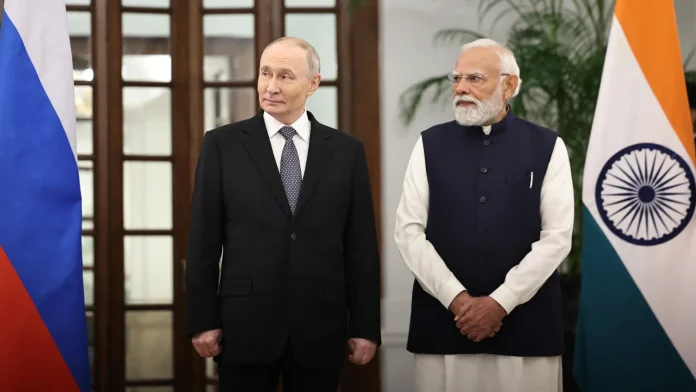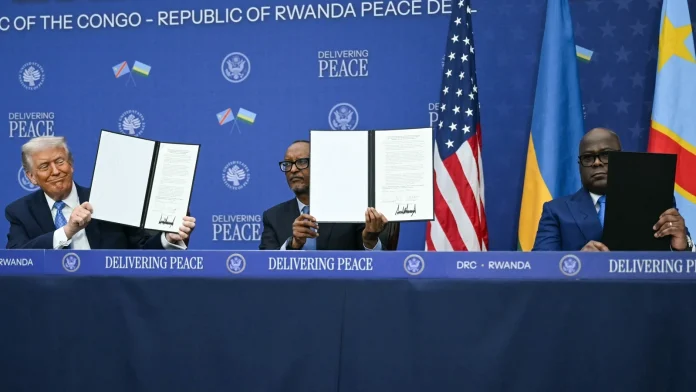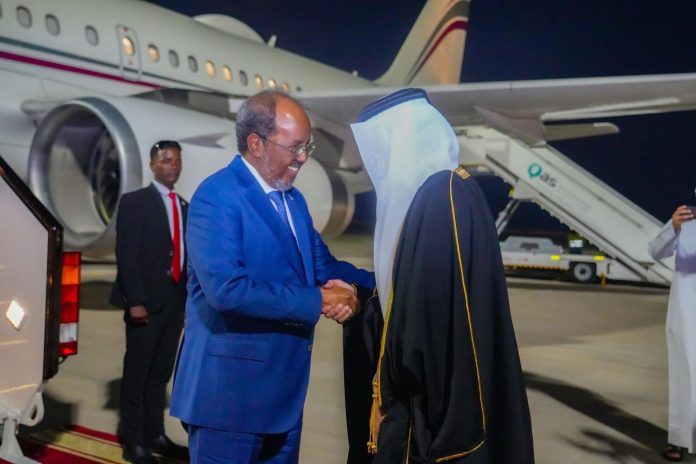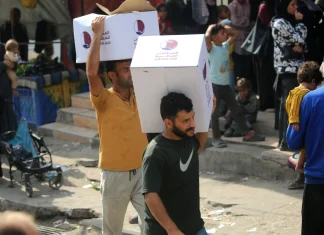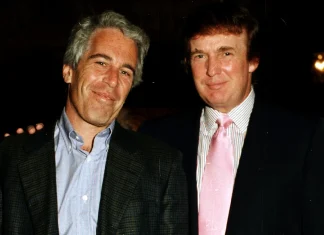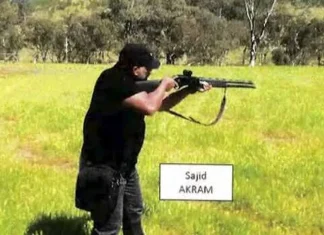Dec 05(Jowhar)-Shir madaxeed dhawaan ka dhacay New Delhi, Madaxweynaha Ruushka Vladimir Putin wuxuu ballanqaaday inuu sii wadi doono bixinta saliidda Hindiya, taasoo xoojinaysa iskaashiga tamarta ee xooggan ee u dhexeeya labada dal.
Edinburgh Airport Restores Flight Operations Following IT Outage
Dawn Disruption at Edinburgh: A Morning That Stopped and Then Sighed
There was a strange hush over Edinburgh Airport this morning — a momentary pause in the hum of suitcases, the clatter of trolleys, the rattle of boarding calls. For a few tense hours, flights were grounded after an issue with the airport’s contracted air traffic control provider. By mid-morning, operations had resumed, but not before the pause left its mark on travellers and staff who live daily with the fragile choreography of modern flight.
I arrived as the airport was just waking up: coffee cups in hands, weary families and business travellers hunched over phones, and staff quietly moving through concourses trying to translate technical uncertainty into human reassurance. “We were told to stay put,” a mother of two from Aberdeen told me, cradling a toddler who had already decided that the airport carpet made a fine playground. “You don’t expect to be stranded before you’ve even left the gate.”
What Happened — and What Didn’t
Edinburgh Airport confirmed that the stoppage was caused by a problem with its air traffic control provider. Flights were temporarily suspended as teams worked to diagnose and correct the issue. Crucially, airport officials said the interruption was not connected to a separate, widely reported Cloudflare outage that has affected other web services in recent days.
“We want to be clear — this was an operational matter linked to our contracted ATC provider,” said an airport spokesperson. “Safety is always our priority; the pause was precautionary and flights were resumed once controllers were satisfied that normal operations could continue.”
By the numbers
Edinburgh is no small regional strip. It is the sixth-busiest airport in the United Kingdom, serving some 15.8 million passengers last year, a figure that speaks to its role as Scotland’s major air gateway. That traffic supports hotels, tours, festivals and local jobs — the airport is a lifeline for tourism-heavy Edinburgh, which hosts world-renowned events like the Edinburgh International Festival and the Fringe.
Faces of Delay: Personal Stories from the Terminal
Numbers matter, but so do people. Near gate B12, a young couple from Spain were counting missed connections on a napkin. “We came to see the Fringe — we booked months ago,” said Marta, 28, with a wry half-smile. “Now we have to rebook trains, hotels — and hope we don’t miss the shows.”
On the tarmac, a line pilot I spoke to — who asked not to be named — explained the nervous calculus behind every pause. “When ATC says stop, you stop. It’s not dramatic for us — it’s procedure. But it trickles down; it changes crew hours, fuel calculations, passenger plans. Airports are big, interconnected machines, and one cog can put the whole thing into slow motion.”
Behind the Scenes: Why a Pause Matters
The modern airport relies on an intricate web of systems: radar, communications, clearance procedures and human controllers who orchestrate the sky like a conductor with a thousand instruments. When a provider experiences a glitch — whether technical or procedural — the default response is caution. It is better to delay than to risk lives.
That said, these interruptions reveal vulnerabilities. In an era where travel demand has bounced back strongly from the pandemic slump, airports are carrying heavier loads. Systems stretched by volume and complexity need redundancy. “Resilience is the watchword,” said Dr. Leila Hassan, an aviation systems analyst. “Airports and ATC providers must invest in both technology and human capacity — training, backups, and robust communication channels — to avoid cascade failures.”
Local Color: Edinburgh’s Long Shadow
It is easy to forget, in the panic of the moment, what Edinburgh Airport means to the city. Beneath the Gothic skyline of the Old Town, the airport is a conduit for millions of visitors who come for history, art, and the particular theatricality of the city’s summer festivals. Local cafés rely on footfall from incoming tourists; tours, short-term rentals and the hospitality sector all feel the rhythms of arrivals and departures.
“When flights stop, the ripple is immediate,” said Fiona MacGregor, owner of a small Fringe-era B&B near the Royal Mile. “You lose bookings overnight, staff shifts get awkward. It’s not just about the planes; it’s about income, livelihoods.”
Wider Themes: Infrastructure, Trust, and the Human Cost
Today’s pause in Edinburgh is a vignette of bigger debates: how resilient are our transport networks? How do we balance efficiency with safety? And who pays the hidden cost of delays — the exhausted families, the small business that loses a night’s custom, the crew that must rearrange schedules?
Worldwide, aviation is rebounding. Passenger numbers have mostly recovered to pre-pandemic volumes in many markets, but resilience planning has not always kept pace. Airports, airlines and governments must contend not only with aging infrastructure but also with emerging threats — cyber incidents, weather volatility driven by climate change, and workforce shortages that strain operations during surges.
Questions for readers
- Have you ever been stranded by an airport pause? How did it affect your plans?
- What trade-offs between efficiency and safety feel acceptable to you when travelling?
- Should public authorities require greater transparency from ATC providers about their contingency plans?
Aftermath and Looking Ahead
By late morning the airport was back to business. Announcements resumed, more flights took to the skies, and the lull softened into the familiar bustle. But the episode left a residue of unease — a reminder that even in well-oiled systems, surprise is possible.
“We appreciate passengers’ patience,” the airport spokesperson said, “and we are reviewing the incident with our provider to reduce the likelihood of recurrence.”
On the concourse, people resumed their journeys: some hurried off to catch trains, others to taxis, a few lingering in cafes to reassess itineraries. A teenager with a guitar, headed for a summer open mic, shrugged and smiled. “Travel always has its hiccups,” he mused. “But then, so does life. You learn to roll with it.”
Parting Thought
We build systems to carry us further — to connect cities, families and stories. When they falter, the responses we design tell us about our priorities. Are we satisfied with stops and starts, or will we demand stronger, smarter infrastructure that keeps the world moving even when a single node stumbles? As we step into airports and onto planes, perhaps the larger question we must keep asking is this: how will we safeguard the delicate choreography of travel for the next generation?
Trump oo Shir-guddoomiyay Heshiiskii Taariikhiga ahaa ee Nabadda ee u dhexeeyay DRC iyo Rwanda
Dec 05(Jowhar)-Madaxweyne Donald Trump ayaa mar kale soo dhigay cinwaannada ugu waaweyn, markan doorkiisa ku aaddan dhexdhexaadinta heshiis nabadeed oo taariikhi ah oo dhex maray Jamhuuriyadda Dimuqraadiga ah ee Congo (DRC) iyo Rwanda.
Recent U.S. strike on alleged Pacific drug boat kills four

Fire on the Water: When Counter‑Narcotics Turns into a Night at Sea
There is a particular smell to the ocean after an explosion: diesel, burning plastic, and something metallic that hangs in your nose like a warning. Along the long, low horizon of the eastern Pacific, where fishing boats carve lanes through mist and dolphins arc between wakes, that smell has been arriving more often. Last week, the U.S. military said another attack on a suspected drug-smuggling vessel left four people dead — the latest blow in a campaign that has so far cost more than 87 lives and which is rapidly becoming one of the most contentious uses of American force beyond its borders.
The scene, as released by U.S. Southern Command, is stark: a multi‑engine speedboat driving hard across open water, a sudden flash, and then the craft shuddering and erupting in fire. “Intelligence confirmed that the vessel was carrying illicit narcotics and transiting along a known narco‑trafficking route in the Eastern Pacific,” the command wrote. “Four male narco‑terrorists aboard the vessel were killed.”
This time the target, officials said, was a vessel operated by a “Designated Terrorist Organisation.” But for many, the labels — terrorist, narcotics trafficker, maritime target — don’t erase the images that haunt them: bodies in the water, a charred hull, and questions about who decided what and why.
The Politics of Precision
In Washington, the strike reopened a political fight that had been simmering for weeks after an earlier September engagement. That incident — in which U.S. forces struck wreckage of a boat that had already been struck and reportedly killed two survivors — has become the fulcrum of outrage and legal scrutiny.
“It is one of the most troubling things I’ve seen in my time in public service,” said Representative Jim Himes after viewing extended footage of that earlier strike at a classified briefing on Capitol Hill. Lawmakers were shown material that the public has only seen in clipped portions, and reactions ranged from moral alarm to firm defense.
“The first strike, the second strike, and the third and the fourth strike on 2 September were entirely lawful and needful,” countered another lawmaker at the briefing, underscoring the deep partisan divide over the campaign’s legality and necessity.
The White House and Pentagon have sought to draw lines of accountability — pointing fingers, in public, at Admiral Frank Bradley, the commander who oversaw the operation, and trying to distance other senior officials from the decisions that culminated in those deaths. That bureaucratic dance has done little to calm the waters.
Questions That Will Not Go Quiet
How much intelligence is enough to authorize a lethal strike on the open sea? When do suspected traffickers become “narco‑terrorists” and thus legitimate military targets? And who bears responsibility if civilians — or people rendered helpless by damage — are killed?
These are not academic questions. They are the kinds of questions that prosecutors, senators, and international law scholars will insist on answering if calls for investigations grow louder.
Coastlines, Communities, and the Human Cost
To understand what’s at stake, you must imagine the coastal towns that dot the Pacific rim: small wooden piers, markets where fish are weighed on creaky scales, women sorting lobsters under tarps, children running after stray dogs. For communities from Chocó’s mangroves to the banana‑belt ports farther north, the sea is livelihood and risk, history and hazard.
A fisherman in one such town, who asked not to be named for fear of reprisal, told me, “We have always known the sea takes. But this is different — I can smell the smoke from a strike and think of fathers we know who were on those boats.”
There are also practical fears. Increased militarization of sea lanes — carrier strike groups, surveillance drones, and fast coastal interdiction teams — can make life harder for legitimate mariners. Routes once used by small traders and fishermen are now monitored for narco‑traffic, and some captains say that the heightened tempo of patrols interferes with seasonal fishing grounds and raises insurance and operating costs.
Regional Ripples: Diplomacy and Distrust
It was predictable that Latin American capitals would react. Venezuela’s President Nicolás Maduro has accused the United States of using a counter‑drug campaign as a cover for regime change — a charge the U.S. rejects — and regional leaders, from coastal ministers to human‑rights advocates, have warned of blowback.
“Aerial or naval power cannot substitute for development,” said a Latin American policy analyst in Bogotá. “If we want to choke the narco‑economy, we need more than bullets: we need rule of law, job creation, and regional cooperation that isn’t perceived as occupation.”
For some governments, tighter cooperation with the United States has been embraced as pragmatic. For others, it is a sovereignty test. The image of the U.S. deploying what the White House described as the world’s largest aircraft carrier and other assets to the Caribbean — ostensibly for counter‑narcotics operations — rekindles old memories of intervention and a skepticism about motives.
Data and Dilemmas
Public figures offered by U.S. officials and international agencies show why the administration casts the problem in stark terms: cocaine and other illicit substances move westward across the Pacific and into markets where demand is high. The U.S. labels certain groups “narco‑terrorists” when they are believed to use drug profits to fund broader violent campaigns, an assertion that raises legal thresholds for kinetic action.
Still, the tally of more than 87 lives lost in this campaign — a number that has multiplied through a series of engagements — begs a sobering question: are we willing to accept this body count as the cost of disrupting supply chains? Or does the number force a rethink of tactics?
Voices from the Sea and the Halls of Power
On the docks, people speak in short, blunt sentences. “We don’t want traffickers, but we also don’t want our boys shot like prey,” one dockworker said, tapping the wood beneath his palm as if to measure the pulse of the place.
In Washington, the conversation is more procedural. A congressional aide explained, “Members wanted to see the raw footage. They wanted to know what the commanders saw in the moment. That’s how oversight works — you hold the wielders of force to account.”
And in a neighborhood clinic in a coastal town, a nurse shrugged and said, “We have drug addiction here, we have poverty here. Strikes on boats don’t feed mouths.”
Where Do We Go From Here?
There are no easy answers. The ocean is vast and indifferent. Narcotics networks are adaptable. Political rhetoric promises decisive action; law and ethics demand restraint and proof. The cameras that captured those blazing boats have given the public a rare view into the mechanics of modern warfare against non‑state actors, but they have also raised a mirror question: what kind of country — and what kind of world — are we willing to build with this tool?
As you read this, consider the tradeoffs. Is it sufficient to measure success in interdictions and seizures? Or should we weigh the shadow costs — the families left behind, the diplomatic strains, the legal precedents? What would you do if charged with protecting citizens while preventing state overreach?
The sea will keep moving. The debate will not. And those who live and work along the narco‑routes will continue to taste, in their lungs and memories, the tang of smoke that follows a strike. Whether that smell becomes a promise of safety or the scent of a campaign gone too far is a choice that belongs to all of us, not just to commanders at sea.
Madaxweyne Xasan oo gaaray magaalada Doxa si uu uga qeyb galo shirka Siyaasada iyo Amniga
Dec 05(Jowhar)-Madaxweynaha Jamhuuriyadda Federaalka Soomaaliya Mudane Xasan Sheekh Maxamuud ayaa gaaray magaalada Dooxa ee dalka Qatar, halkaas oo uu kaga qeyb-galayo Madasha Dooxa ee lagaga arrinsanayo amniga, siyaasadda iyo iskaashiga horumarineed.
Putin Promises Continuous Oil Supplies to India at Summit
Delhi’s Long Embrace: Oil, Occasions, and the Art of Diplomatic Balance
New Delhi rolled out a ceremonial carpet this week—flags snapping, brass gleaming, an honour guard in starched uniforms—yet the pomp was only the prelude to a far quieter, more combustible drama: the flow of oil that keeps factories humming, buses moving, and political engines burning on two continents.
President Vladimir Putin arrived under a 21-gun salute and tight security, a state visit that felt both historic and fraying at the edges. For a country that has long prized strategic autonomy, the summit was a study in contradictions—handshakes and banquet halls shadowed by sanctions, tariffs, and an American ultimatum that has put New Delhi in a diplomatic vise.
Energy first, always
“Energy security is not an abstract policy; it’s a daily fact,” said a veteran oil analyst in Mumbai, watching the motorcade from his office window. “When refineries need crude, you do not negotiate morality—you negotiate pipelines, pricing, and delivery dates.”
India’s appetite for crude has turned Moscow into a central supplier. In 2024, nearly 36% of India’s total crude imports — roughly 1.8 million barrels per day — came from Russia, much of it at discounted rates that have helped refiners lock in margins even as global prices oscillate.
That dependence is the hinge around which this summit spun. Behind closed doors, trade delegations agreed to expand economic ties through 2030, and government officials sketched plans to deepen cooperation in nuclear energy, shipping, and technology. Yet for many Indians on the street, the literal image of tankers lining up at western ports is what mattered most.
“If the price is right, my factory can run, my workers can be paid,” said Meera Patel, who runs a small textile unit in Gujarat. “I don’t want politics to make my machines stop.”
Tariffs, pressure, and a diplomatic tightrope
The pressure on New Delhi is unmistakable and public. In August, the United States slapped a sweeping 50% tariff on most Indian products, citing India’s continued purchases of Russian oil as revenue that helps fund Moscow’s war in Ukraine. The punitive measure forced New Delhi to make adjustments—imports from Russia have been reduced in recent months—but it did not sever the relationship.
“India has to walk a balancing act,” explained a former diplomat familiar with Indo-Russian ties. “We are navigating strategic needs—defence, energy, long-term partnerships—while also trying not to collapse a more valuable commercial relationship with the US.”
That balancing act is visible in the figures. Bilateral trade between India and Russia surged to $68.7 billion in 2024–25—almost six times the level before the pandemic—but Indian exports to Russia were modest by comparison, totaling about $4.88 billion. The asymmetry fuels a sense that the relationship is tilted toward Russian exports—oil above all—while India seeks more balanced reciprocity.
Beyond the bouquets: defence, industry, and diversifying suppliers
Russia has long been a principal supplier of military hardware to India. But that dependence has been changing. Data from the Stockholm International Peace Research Institute shows the Russian share of India’s arms imports fell from 76% in 2009–13 to 36% in 2019–23, a sign that New Delhi is opening its doors to alternative suppliers and boosting domestic production.
“We are not breaking old friendships; we are broadening them,” said an Indian defence official. “Our procurement policies are pragmatic. We buy what we need, where we can get the technology, transfer of know-how, and domestic industrial benefits.”
This summit, then, was less about romance and more about transaction—intellectual property, joint ventures, and access to markets. Delegations signed deals covering jobs, health, chemicals, and shipping, and sketched joint programmes that New Delhi hopes will reduce its trade gap while maintaining energy and defence ties.
- Trade and investment framework to 2030
- Agreements on shipping and maritime cooperation
- Collaborations in nuclear energy and research
Voices from the capital and the coast
On a narrow lane not far from the presidential palace, an auto-rickshaw driver named Arjun watched the televised ceremonies and shrugged. “They talk about strategy,” he said, “but my family worries about diesel prices. Diplomacy must come home.”
At the Jamnagar refinery complex in Gujarat—one of India’s largest—the hum of pumps and boilers tells its own story: global geopolitics is processed into diesel and jet fuel, refined into everyday life. A site manager there commented, “When you lose a supplier, you scramble. With Russian crude, we have certainty of tonnage and often price. If that changes overnight, the shock is felt across the board.”
Meanwhile, an energy economist in Delhi warned against simplifications. “Discounted Russian barrels are not a free lunch,” she said. “They alter market signals, affect the viability of other suppliers, and complicate India’s relationships with Western powers—especially when those powers tie oil purchases to geopolitical objectives.”
What does the world see?
For Washington, India’s purchases of Russian oil are not merely commercial; they are part of a larger conversation about sanctions, accountability, and the cost of war. For Moscow, India has become both a customer and a diplomatic counterweight. For India, it is a pragmatic choice in a world of limited options.
“We want to be friends with everyone,” the former diplomat said quietly. “But sometimes being friends means tolerating differences. India’s calculus is shaped by geography, development needs, and domestic politics.”
The bigger picture: energy, sovereignty, and the new maps of power
Ask yourself: should energy policy be insulated from moral judgments, or is it inevitably political? As nations try to insulate their economies from shocks, the modern map of influence is sketched not with borders but with pipelines, ports, and payment mechanisms. India’s choices reflect a growing global reality—middle powers asserting agency amid competing pressures from old allies and new coalitions.
Putin’s message here was plain: Russia can keep the taps open. New Delhi’s reply was subtler: it will keep buying where it serves its needs, but it will also expand partnerships, diversify arms suppliers, and pursue domestic manufacturing.
“This isn’t a romance novel,” said a political analyst in New Delhi. “It’s an economic ledger with pages being written in real time.”
By the time the state banquet ended and the last toasts were made, the headlines had been written. But the real story will be measured in shipments, contracts, and decisions made in boardrooms and ministries over the coming months.
Will New Delhi find a path that satisfies both its strategic autonomy and its commercial relationships? Or will global politics force a sharper choice between friends? Keep watching the tankers—their itinerary may tell you more about the future than any summit speech.
TikTok Agrees to Follow Australia’s ‘Upsetting’ Under-16 Ban

A Quiet Morning in December: When TikTok Turns Off for a Generation
On a bright December morning in suburban Melbourne, the hum of scooters and the smell of toast mingled with the brittle silence of an app going dark.
“I woke up, opened TikTok like every day, and it was gone,” said Jordan Ellis, a 15-year-old who lives near the Yarra River. “At first I thought it was a glitch. Then my friends started messaging: ‘They blocked us.’ It felt like someone took a piece of our social life.”
Jordan’s confusion captures the intimate disorientation millions of teenagers across Australia may feel on 10 December, the day a world-first law comes into force that will bar anyone under 16 from opening new social media accounts. Platforms — from global giants to smaller sites — are required to make “reasonable steps” to enforce the restriction or face fines of up to €27 million (roughly AUD 45 million, depending on exchange rates).
What Will Change — And What Won’t
The practicalities are stark. Where previously a child could download an app and sign up in minutes, companies will now block account creation for people who declare they are under 16 in Australia. Existing accounts owned by under-16s will be made inactive. Platforms say they will give users choices: confirm age, delete an account, download data, or request a reminder to reactivate once they turn 16.
TikTok, which hosts billions of videos and has become a cultural heartbeat for many young people, announced it will comply on day one. The company has said that blocked users can appeal by proving their age using documents such as ID, credit card authorisation, or, controversially, facial images.
“We understand this will be upsetting for some families, but we intend to follow Australian law,” a spokesperson for TikTok said in a brief statement. “We encourage parents to speak with their children about honesty online and to plan together for safe digital lives.”
Options for Young Users
- Confirm age with official documents or other verification methods.
- Download personal data before the account is deactivated.
- Delete the account voluntarily.
- Request a reminder to reactivate the account when the user reaches 16.
Between Protection and Privacy
The law is animated by real anxieties. Communications Minister Anika Wells has been blunt in stating that some young Australians have taken their own lives after being drawn into algorithmic loops that amplified content feeding low self-esteem and self-harm. “This law won’t fix everything,” she told reporters in recent weeks, “but it will give kids a chance to grow without those relentless nudges.”
That plea sits next to a chorus of sharp questions. How do you stop harm without stripping agency? How do you police age without turning teenagers’ faces into biometric keys?
“You can’t treat children as if they’re naïve consumers and then ask them to hand over their faces to prove otherwise,” said Dr. Maya Rahman, a child psychologist who has worked with adolescents in Sydney for two decades. “Biometric verification creates a new set of risks — privacy erosion, potential misuse of data, and discrimination when systems misread diverse faces.”
Parents here are split. Tara Nguyen, a mother of two in Brisbane, welcomed the change. “My younger one is 12 and comes home upset after scrolling. If this law gives us breathing space to teach empathy and resilience before they’re exposed to everything, I’m for it,” she said.
Others fret about equity. “Not every family can provide alternate activities or adult supervision,” said Lee O’Connell, a youth worker in remote New South Wales. “If digital life is closed off, we need to ensure kids still have constructive ways to connect. Otherwise we disproportionately isolate children already living with fewer opportunities.”
Legal Battles and Global Ripples
Not everyone supports the ban. The Digital Freedom Project has launched a High Court challenge, describing the law as an “unfair assault on freedom of expression.” The group argues the measure overreaches and risks upending civil liberties online.
“We’re not against protecting kids,” said a representative for the group, speaking on background. “But sweeping blocks and invasive verification demands can do as much harm as good if they’re not calibrated and transparent.”
Internationally, Melbourne’s experiment has become a case study. New Zealand has signalled similar moves, Malaysia hinted at a ban for under-16s, and regulators in Ireland have signed a memorandum of understanding with Australia’s eSafety Commissioner to share best practices and technical expertise. In a world where digital harms and the tools to regulate them move faster than lawmaking, Australia’s law will be watched closely — and critiqued loudly.
Numbers That Frame the Debate
Some data help explain why this is so contentious. Surveys suggest that large majorities of teens are active on social platforms — daily and often for hours. In many high-income countries, more than 80% of teenagers report using social media regularly, and a significant share say they encounter bullying, body-image pressures, or other distressing content there. Mental health services report rising demand from young people struggling with anxiety and depression, trends experts often link, at least in part, to screen time and online social pressures.
At the same time, platforms are hubs for creativity, community, and civic engagement. For many adolescents, the first taste of identity and activism comes via a viral clip or a supportive comment thread. Barring them entirely risks cutting off pathways that can be, for some, lifelines.
On the Ground: Stories That Don’t Fit a Headline
Walk past a surf shop in Bondi and you’ll hear a different refrain than in a Melbourne laneway café. The kids in coastal towns share tips about skateboards and beach cleanups; those in inner-city suburbs remix politics and fashion into short films. Social media is where they rehearse adulthood — awkwardly, loudly, colorfully.
“We made a fundraiser for a mate who needed surgery,” said Aisha, 17, a student in Perth. “TikTok helped us raise money and get people together. I worry about losing that tool.”
Her fear is a reminder: laws that move in pursuit of safety can also trim back the shared public square. The trick, if there is one, will be designing protections that are specific, evidence-based, and attuned to the diversity of young lives.
Questions to Sit With
Which matters more — shielding all children from a platform’s risks or trusting families to decide what’s best? How do we weigh privacy against protection when the technology of proof is invasive? And who gets to define childhood in the digital age?
As Australia turns this page, the rest of the world will read it closely. Regulators, tech companies, parents, young people, and privacy advocates will all bring their own margins of error. There will be messy implementation, courtrooms, late-night conversations at kitchen tables, and maybe, eventually, better tools that respect both safety and autonomy.
Jordan closed his laptop the day the block appeared and went for a walk along the river. “It felt weird,” he said, watching a pelican dive. “Without the constant scroll, I noticed things — the light on the water, people laughing. Maybe that’s the point, for a while.”
For policymakers and parents, the task now is to make that “while” as generative and just as possible. For readers around the globe: what would you want for the digital childhoods in your life? How would you balance protection with possibility? The answer will shape not only a law that starts on a single day in December, but the stories we let our children write about themselves online for years to come.
Trump Presides Over Historic Signing of Peace Accord Between DRC and Rwanda
When Handshakes Meet Heavy Artillery: Washington’s Peace Ceremony and the War Still Burning in Eastern Congo
On a crisp Washington morning, beneath banners that read “Delivering Peace,” three presidents took their seats at a polished table and signed documents that, on paper, promised to chart a new course for the Great Lakes region of Africa.
It was a scene staged with all the theatre of modern diplomacy: cameras, prepared remarks, a building briefly stamped with a new name, and the sort of confident smiles that look good on television. But thousands of miles away, in the patchwork hills and wet markets of South Kivu, life continued under the thunder of artillery and the thin air of uncertainty.
The ceremony — optics vs. reality
Inside the room, the leaders of Rwanda and the Democratic Republic of Congo committed to an economic integration compact and a US-brokered peace framework. They signed an additional deal aimed at governing access to critical minerals — the raw materials that have turned eastern Congo into the prize at the center of a global scramble.
“This moment was framed as a turning point,” a senior White House official told me, speaking on background. “The message was: we’re resetting relations, we’re opening markets, and we’re stabilizing a volatile region.”
But the cameras could not show what many Congolese woke up to that same morning: reports of clashes between the Rwanda-backed M23 rebel group and Congolese government forces across several towns in South Kivu. A front-line farmer described the sound of shelling: “It was like thunder that didn’t stop. We hid the children among the yams,” she said, her voice flat with exhaustion.
On the ground: markets, mothers, and mortar fire
Visit a market in Bukavu or a roadside tea stall near the Rwandan border and you feel the region’s pulse: a mixture of resilience, suspicion, and quiet grief. Women still sell ripe avocados and crisp cassava chips from tarp-covered stalls. Children play under the shade of jacaranda trees. Yet beneath that ordinary life there is an economy strained by displacement, checkpoints and the invisible tax of fear.
“We are not on the same page as our leaders,” said Jean-Pierre, a taxi driver who ferries people to IDP camps. “They shake hands in the capital. We run from bullets in the bush.”
Humanitarian agencies estimate hundreds of thousands have been displaced in the past year in eastern DRC — a number that fluctuates with the ebb and flow of front lines. Clinics are overwhelmed. Survivors of sexual violence, for which eastern Congo has a tragic reputation, still face long waits for care. The Nobel laureate who works with survivors has called the accords “insufficient” and warned that mineral interests are overshadowing the human toll — a critique shared by many local activists.
Critical minerals: the invisible engine
To understand why the room in Washington mattered so much to distant capitals, look beneath the soil. Eastern Congo is threaded with the minerals that the 21st-century economy consumes: cobalt for batteries, copper for electrification, tantalum for electronics, and gold and tin that have financed both livelihoods and conflict.
DRC’s mining sector supplies a sizeable share of global cobalt production — estimates over recent years have often put the country’s share at well over half of world output — and it hosts some of the world’s most important copper reserves. Artisanal miners, often working by hand, number in the hundreds of thousands; mining towns buzz with an uneasy commerce where fortunes and tragedies are both made.
“This is geopolitics in a hole in the ground,” said Amina Komba, an African affairs analyst based in Nairobi. “For Washington, access to minerals is a strategic priority in the competition with China and other global players. That changes how agreements are negotiated and what is foregrounded: mineral governance and investment, sometimes before security and justice.”
- Tantalum, tin and tungsten — often called “3T” — are critical for electronics.
- Cobalt and copper underpin the green-energy transition, feeding batteries and power grids.
- Estimates suggest the DRC is a major global source of several of these minerals, making it a focal point for foreign investors and foreign policy alike.
Who is at the table — and who is left out?
One of the most striking features of the Washington ceremony was who did not attend. M23, the rebel group that has seized territory on and off in eastern Congo, was not a party to the signing. The group continues to press militarily in provinces that have seen some of the most intense violence in recent months.
A Congolese government spokesman in Washington insisted the agreement “recommits both parties to the peace process,” but on the ground, fighters do not take oaths written on embassy letterhead. The deal calls for Rwanda to withdraw forces and for the DRC to act against certain armed groups — but observers say little concrete progress has been visible since the accords were first discussed.
“You can sign all the instruments you like,” said Dr. Helena Mutesa, a regional security specialist. “But if the militia commanders are not bought in, and if livelihoods are not restored, the terms are paper thin. Real peace requires local buy-in, accountability, and reconstruction.”
What this means for the wider world
What transpires in the hills of eastern Congo ripples outward. Western manufacturing, electric-vehicle supply chains, and global diplomatic alignments all have a stake in whether minerals are sourced responsibly and whether violence is contained.
There is also a broader moral question for readers far from the conflict: can we, as consumers and citizens, tolerate supply chains that are built atop human suffering? The recent agreement promises economic integration and investment — potentially billions of dollars — but will that capital prioritize community needs, environmental protection, and transparent governance?
“Investment that doesn’t transform local economies into something stable and diverse will only deepen dependency,” said Komba. “If profits leave the region while people remain insecure, we’ve solved nothing.”
Closing: a fragile promise
Washington’s signing ceremony was, undeniably, a diplomatic moment. Presidents clasped pens; photographers clicked; a newly emblazoned sign outside a peace institute drew headlines. For policymakers in capitals around the world, a framework for economic cooperation and mineral governance is an appealing narrative.
But the real test will play out in muddy fields, in clinics and schools, in the conversations at market stalls and in the quiet rooms where mothers stitch mattresses for children who have slept in churches and under plastic sheeting. Peace that is resilient must be felt in the everyday — in the return of traders to their routes, in children walking safely to school, in survivors receiving care and in community leaders having a voice in how land and resources are managed.
So ask yourself: when you charge your phone or buy a car, whose labor and conflict might be hidden in that supply chain? And when leaders sign treaties in capital cities, are the people who live under the shadow of those decisions being listened to?
Diplomacy has opened a door. Whether it becomes a doorway out of conflict or just another corridor to mine wealth depends on tough follow-through, local participation, and — most of all — the willingness of the international community to put people before profit.
Putin Vows to Seize Donbas Despite Renewed US–Ukraine Talks

On the Edge of Donbas: A Quiet That Never Settles
There is a peculiar hush that has settled over parts of eastern Ukraine — not the peaceful kind, but the brittle silence that follows a distant explosion. In Donbas, towns are stitched together by concrete, steelworks and memory. Their people move like ghosts through grocery aisles that used to hum, past apartment blocks that hang on like stubborn punctuation marks against the horizon. You can feel the history in the air: the coal dust of an industrial past, the smell of black bread cooling on a windowsill, the radio news counting the day’s losses and the day’s small mercies.
“We joke that winter is more honest than war — at least it shows everything,” says a volunteer who ferries medicines between checkpoints. “But we have been living in a winter of the soul for years now.”
Putin’s Ultimatum and the Map of Control
In a recent interview, Russian President Vladimir Putin laid down a stark choice: either Russia will seize the entirety of the Donbas by force, or Ukrainian troops must withdraw. “Either we liberate these territories by force of arms, or Ukrainian troops leave these territories,” he told India Today — words broadcast back across the region like a renewed order to soldiers and commanders.
Putin’s declaration did not emerge from nowhere. For the past decade, since 2014, the Donetsk and Luhansk regions have been the epicenter of simmering and then full-blown conflict. In February 2022 the simmer became inferno when Russian forces launched a large-scale invasion of Ukraine. Today, Moscow controls roughly 19.2% of Ukrainian territory — including Crimea (annexed in 2014), all of Luhansk, more than 80% of Donetsk, about 75% of Kherson and Zaporizhzhia, and strips of other regions. Only about 5,000 square kilometers of Donetsk remain under Kyiv’s control.
These numbers are more than statistics. They are towns and schools and hospital wards. They are the route maps of families who have had to decide whether to stay, flee, or try to carve normalcy out of bombardment.
Voices From the Ground
“When the sirens go off, we don’t run like in the movies,” a schoolteacher from Sloviansk told me over a thermos of tea. “We take the children to the basement, count to ten, and tell stories. It’s how we keep the future from breaking.”
At a makeshift humanitarian hub, a volunteer doctor — who asked only to be called Oksana — described treating crush injuries from shelling and the mounting mental toll. “The physical wounds can heal,” she said. “It’s the nights full of tremors that scar you.”
Diplomacy in the Shadow of Guns
Diplomacy has, at times, been equally brittle. In recent weeks, an American delegation led by Steve Witkoff and Jared Kushner met with President Putin in the Kremlin. The talks produced no breakthrough, with the Kremlin saying large parts of the U.S. plan were unacceptable. U.S. President Donald Trump later told reporters that Putin “would like to end the war” — a reflection of the small optimism that lights hope in diplomatic corridors even when the battlefield tells a different story.
U.S. envoys were expected to debrief Ukraine’s chief negotiator, Rustem Umerov, in Florida — a reminder of how any potential resolution must thread a needle between Moscow’s demands and Kyiv’s resolve.
“There is a window of opportunity,” Ukrainian President Volodymyr Zelensky said in a televised address, “but it must be accompanied by pressure on Russia.”
On the Table — and Off
So what is being discussed? Public reports suggest Russia is demanding control over the entire Donbas, along with international, if informal, recognition of its gains. Western allies are scared of arrangements that seem to reward conquest. European capitals are scrambling to harmonize positions: NATO announced purchases of hundreds of millions of dollars in weapons for Ukraine, while Brussels debated a “reparations loan” — a plan to use Russian state assets frozen across the EU to support Kyiv’s reconstruction. Belgium, the chief custodian of much of those assets, has raised legal concerns; Germany’s chancellor urged shared risk-bearing.
“Any deal that asks Ukraine to cede territory will be a bitter pill,” said an analyst in London. “It would set a dangerous precedent about the power of force over law.”
Children, Camps, and the Crime of Displacement
Beyond geopolitics, there are stories that cut to the heart of why the war has become a moral litmus test for the international community. Kyiv alleges that Russia has abducted nearly 20,000 children from occupied territories since 2022 and shipped some of them to re-education sites — not only within Russia and Belarus but reportedly as far as North Korea. Ukrainian human-rights officials say a network of 165 camps operates across the region, a chilling bureaucratic architecture for forced assimilation.
“We once found a set of drawings a child had made — rockets, soldiers, and a little house,” a lawyer who documents family separations recalled. “The little house was full of tears.”
These actions have already drawn grave international attention: the International Criminal Court issued arrest warrants in 2023 related to the alleged deportation and transfer of Ukrainian children.
Frontline Realities and the Cost of ‘Progress’
On the ground, Russian advances have gained momentum in recent weeks, Russian officials say, citing battlefield successes that they argue strengthen Moscow’s negotiating hand. Kyiv, however, rejects the logic of conceding territory as a price for peace. Fighting remains fierce in pockets like Pokrovsk, where claims of capture are countered by Ukrainian units who report ongoing urban combat.
“You can claim a map,” one Ukrainian officer said over encrypted radio, “but you cannot claim a people’s memory.”
Why This Matters to the World
This conflict, for all its local specificity, sits at the intersection of global anxieties about borders, sovereignty and the resilience of the post–World War II order. If force becomes an efficient path to redrawing maps, what does that mean for smaller states watching, nervous in their peripheries? The Donbas fight is also a test of alliance politics: can NATO and the EU synchronize support in a way that preserves both Ukraine’s sovereignty and a meaningful negotiating posture?
For ordinary people, these geopolitics are not abstractions. They determine whether a child can return to school, whether a hospital receives diagnostic equipment, whether a family can sleep without the fear of evacuation orders at dawn.
What Comes Next?
There are no easy answers. Diplomats will continue to shuttle between capitals and front lines, and armies will measure terrain by the cold calculus of artillery and supply lines. But the human ledger keeps adding up: displaced families, abducted children, and towns like slow-motion ruins that still host laughter in basements and stubborn cups of tea.
So I ask you, reader: when the world debates maps in conference rooms, who will tell the stories of those who live on the margins of those lines? Whose pain gets counted, and whose does not? The Donbas is more than a symbol — it is lives, histories and futures. And whatever the outcome, the question remains: can any peace that comes without justice ever truly be lasting?
As the sun sets over those scarred fields, someone in Donbas will light a candle for someone lost and keep a watch on the road. That small, human act — stubborn, ordinary, almost sacred — is the true measure of resilience in a war that has tried, again and again, to break people’s capacity to hope.
Family of Novichok Victim Rejects Conclusions of Public Inquiry Report
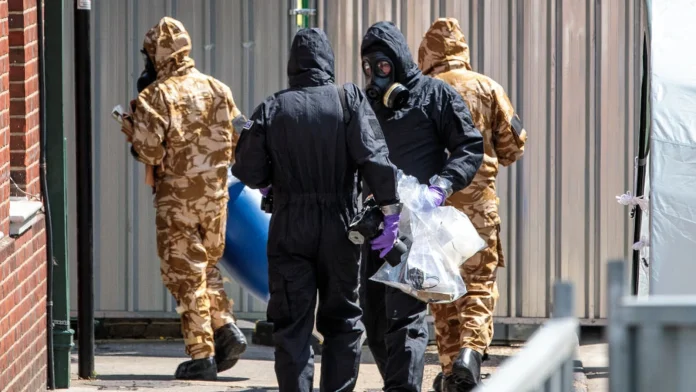
A Quiet Town, a Loud Reckoning: The Fallout from the Novichok Inquiry
On a cool Wiltshire morning, the air over Amesbury felt ordinary in a way that made the headlines sting all the more. Pigeons shuffled on the high street; a woman swept leaves outside a charity shop. But the hush contained a rawness — the kind of collective intake of breath a town gives when it remembers that something terrible once happened here and no one was ever truly satisfied with the explanation.
That dissatisfaction has returned like an old ache after the publication of the final inquiry into the nerve-agent poisoning that claimed the life of 44-year-old Dawn Sturgess. The report pointed an unflinching finger at the Russian military intelligence agency, the GRU, and at President Vladimir Putin’s leadership; but it left the families wanting more than blame. They wanted change.
The family’s call: reflection, responsibility, and reform
“We can have Dawn back now,” her father, Stan Sturgess, told reporters with the flat, exhausted relief of someone who has spent years living with a public tragedy. “She’s been public for seven years. We can finally put her to peace.”
His words landed in the national consciousness like a bell at the end of a memorial service — equal parts grief and the desire for closure. Yet closure, the family say, must not be just a private act of mourning. “There should, there must, be reflection and real change,” the family’s statement read, calling it “a matter for real concern” that the inquiry chair made no formal recommendations to prevent a similar tragedy.
To the Sturgesses and many in Amesbury, the report stitched a narrative: a Georgian door handle smeared with a lethal chemical, a planned public demonstration of power, and a failures-in-the-gap when it came to assessing and protecting risk. But facts and sentences in a public document do not always translate into policy shifts that stop the next preventable harm.
What the inquiry concluded — and what it did not do
Lord Hughes, the inquiry chair, wrote in stark terms: the operation that led to the poisonings was “astonishingly reckless,” and he placed “moral responsibility” for Dawn’s death at the highest levels of the Russian state. He described how a GRU unit had used the attempt on former spy Sergei Skripal and his daughter Yulia as a demonstration — a message sent in a way that shattered ordinary assumptions about safety in public spaces.
But the report also stopped short of prescribing reforms. It walked through a sequence of events, named the actors, and scolded the recklessness. It did not set out a menu of actionable recommendations for protecting vulnerable people, for improving interagency risk assessments, or for compensating those whose lives had been upended. To the family, that omission feels like an unfinished sentence.
Sanctions, diplomacy, and a message from Westminster
In the hours after the report’s release, the UK government acted — not with the legislative prescription the Sturgesses had asked for, but with punitive measures aimed at the perpetrators. The Foreign Office sanctioned the GRU in its entirety, and designated 11 individuals linked to state-sponsored hostile activities. Eight of those were identified as GRU cyber officers, implicated in operations ranging from malware campaigns to disruptive incidents across Europe; another three were accused of planning plots, including an alleged terror plot targeting supermarkets in Ukraine.
- GRU sanctioned as an organization
- 11 individuals designated for state-sponsored hostile activity
- Eight identified cyber-officers targeted for disruptive cyber operations
- Three additional officers designated for alleged plots in Europe
Prime Minister Keir Starmer characterized Dawn’s death as “a tragedy” and framed the government’s response as part of a broader stance against what he described as Kremlin aggression. “The UK will always stand up to Putin’s brutal regime,” he said, calling the report “a grave reminder of the Kremlin’s disregard for innocent lives.” The UK also summoned Moscow’s ambassador, a diplomatic gesture that is both a rebuke and a spotlight.
Amesbury remembers — and asks questions
Walk the quiet lanes of Amesbury and you will hear the ordinary sounds of an English market town. Yet beneath them there are memorials: flowers long since dried, a candle still clinging to memory, conversations paused out of respect. “We’re a small place,” said a cafe owner who asked not to be named. “When something like this happens, it’s everyone’s story. It’s our friends, our NHS, the police who ran down to help. The report tells us who did it, but not always how to sleep at night.”
Nick Bailey, the police officer who was poisoned while doing his duty that day, survived — like the Skripals — but the costs to his health and to the community were indelible. For neighbors, the episode was not an abstract geopolitical moment but a day of sirens, of cordons, and of the smell of antiseptic that lingered in the air like a ghost.
Experts and the law
Specialists in chemical weapons law and public safety have been watching closely. “The use of a nerve agent on civil streets is a violation of international norms and domestic safety expectations,” said a chemical weapons analyst. “The Chemical Weapons Convention bans these agents and their use represents a fundamental breach of the post-war order we rely on to make public life safe.”
But how nations translate international outrage into better protection for citizens is a thorny policy question. Should every public inquiry set out mandatory reforms? If so, who ensures their implementation? These are complicated governance questions that hover over the Sturgess family’s demand for “real change.”
From a single tragedy to global implications
Why should readers half a world away care about a singular incident in a small English town? Because the story is a prism through which modern challenges focus: statecraft that disregards civilian lives, the expansion of cyber and chemical tools of influence, and fragile systems of accountability in an interconnected world.
When a spy’s residence becomes the stage for a message sent in the most obvious but most dangerous way — contamination on a doorknob — it shatters the line between war and peace. It raises the question: in an era of plausible deniability and hybrid tactics, how do societies rally to protect ordinary people who stumble into crimes of state?
And there is something else: a human truth. Public inquiries can name perpetrators, and governments can issue sanctions; neither guarantees healing. “We wanted lessons,” the family said, returning, insistently, to that point. “Not just answers.”
What now? A call to reflection, not closure
As readers, what do we do with stories like this? We test our tolerance for state violence when it’s far away; we question whether our own institutions are nimble enough to protect us; we ask if naming is enough without changing. We also remember the human faces: a daughter lost, a father who wants to rest his child from the public record, a community still sorting the ordinary from the extraordinary.
In the end, the report offered accountability in the form of attribution and sanction. It did not offer a framework for prevention. The Sturgess family’s plea — “there must be reflection and real change” — is an invitation to action. It asks governments to look not just at international culpability, but at domestic gaps and the simple things that make life safe: risk assessments, timely warning systems, coordinated public health responses.
On the high street in Amesbury, a shopkeeper paused from arranging a window display. “We live with headlines,” she said quietly. “But we live our lives between them. If this town can’t be made safer after what happened, then what good are inquiries at all?”
That question stretches beyond Wiltshire. It asks readers everywhere to consider what justice looks like when state aggression reaches into daily life — and to insist, as the Sturgess family does, that naming the wrongdoer is not the end of the story but the beginning of reform. Will we take it up?


